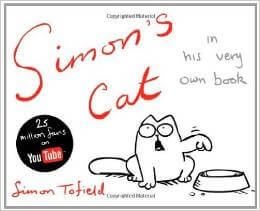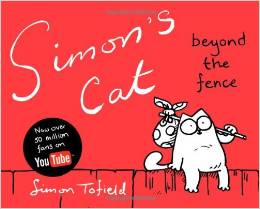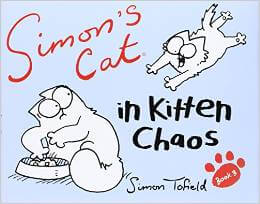Interview: Simon Tofield – The Man Behind Simon’s Cat
At the time of writing this the UK is acting like a pretty negative place to live. Arguments about the Euro, debates about Poppy burning and of course Aardman, the last real bastion of British animation is rumoured to be leaving the country.
In a time of creative insecurity Skwigly shines the spotlight of hope on some of the most eye-opening animators in the UK today. This brings me seamlessly into my introduction to the creator of the Internet phenomenon Simon’s Cat who’s YouTube animations combined have more views than the Bible. OK that’s not even remotely true but you can almost believe it with his popularity. The origin of Simon Tofield’s success is completely self generated and his deceptively simple art style using a readily available software is the reason he is probably one of the most encouraging and inspirational success stories of the millennium.

Simon Tofield
You epitomise the YouTube success story. Did you imagine this kind of result from uploading that first animation?
The first Simon’s Cat film, ‘Cat Man Do’ was actually a learning exercise I set myself in order to learn Flash. It wasn’t part of any grand scheme, and was supposed to be just a one off. I never imagined much would come of it. How it was received, with now over 27 million views on YouTube was a massive surprise.
On average how long does each short take to produce?
On average it takes about 6-7 weeks to do the animation. And then it takes a further week to do the sound. The films aren’t all the same length so the time needed goes up and down.
What were you doing whilst animating that first episode? Were you working or did you invest all your time into the projects?
At the time I was still freelancing. The first episode was just something done to the side in my free time.
The teaming up with sound artist Shrooty Was a match made in heaven… How did you two get involved?
Shrooty is actually a guy called Russell Pay. I’ve known him for years as he works closely with the animation studio TANDEM, which is where I got my first job after graduating from university. I was freelancing at TANDEM when I needed to have sound made for Cat Man Do, so Russell was a natural choice to work with. When we work together, I make the sounds for the cats and other animals, like the hedgehog. Russell produces all the foley, which is backround noises and effects.

Your real life cats have been a lot of the inspiration for the series… And you often attend events like Birmingham NEC’s Supreme Cat Show. Do your cats come with you as celebrities of the feline world?
Haha. They are blissfully unaware of their influence on my animation and the impact those films have made. Even if they did know, I think they’d still prefer to stay home closer to their food and beds!
Even though your animations are based on cat observations, the enormous fan-base of your work isn’t restricted to ‘cat lovers’. Why do you think so many different kinds of people enjoy your work?
Certain types of humour are universal. Simon’s Cat has a lot of visual comedy, which transcends age, sex and even international boundaries. As you know Simon’s Cat has no dialogue, so it relies very much on the body language of the characters. Body language, in animals anyway, is very universal, and understood wherever you are in the world.
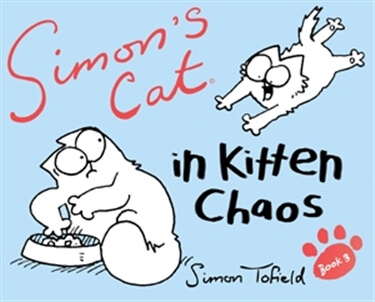 You’ve just released your third book Kitten Chaos and unlike the previous two this time it’s more narrative based. Is this a taster of much bigger Plans for the series? Maybe something feature length?
You’ve just released your third book Kitten Chaos and unlike the previous two this time it’s more narrative based. Is this a taster of much bigger Plans for the series? Maybe something feature length?
I think the second book also had a strong narrative, but you are correct that the narrative of the books is getting more obvious. There is already an overarching narrative in the series, but that is realised over time as it reveals itself and you learn the relationship between Simon and Simon’s Cat. There are thoughts about making a longer Simon’s Cat, but that’s still in development, and I don’t want to say too much about that until there’s something definite to announce.
Regarding the distinct style you’ve developed who are your biggest inspirations in illustration and animation?
I first got into animation watching Saturday morning cartoons. I know it sounds a bit funny, especially if you go back and watch an episode now, but I really loved Transformers as a kid. Trying to copy the animation of the TV series, and drawing robots was what got me started down the path of animation. Regarding illustration, I’ve always admired the work of Bill Watterson who created Calvin and Hobbes. Also Gary Larson of The Far Side.
You quickly became a figure for the RSPCA with your Simon’s Sister’s dog ‘fed up’ animation and various on-line competitions and sponsorships. How did that come about?
The Simon’s Sister’s Dog film was made after the RSPCA approached me asking if I could help make a film highlighting the problems of pet overfeeding and obesity. The first thought was to use Simon’s Cat, but Simon’s Cat is a bit a too smart to end up letting himself get overfed. So it instead fell to Simon’s Sister’s Dog, who in the books is a bit more of a fall guy, and better for illustrating the point that needed to be made. I’m also the patron of my local cat sanctuary called Stray Cat Rescue. They introduced me to two of my real-life cats, so I felt it important to lend my support to them.
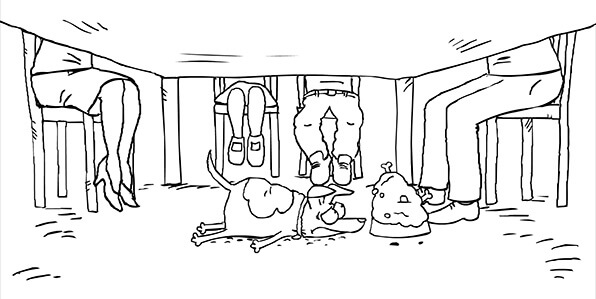
How easy was the transition from creating animations to doing the comic strips for the Mirror?
By the time the Mirror comic opportunity came around I had already two Simon’s Cat books under my belt. They are large books. 240 pages each. So I was already acclimatised to telling stories with just few drawings.
Unlike other animal based comics you don’t have any script. Does this restrict the possibilities of what you can do with the Simon’s Cat stories?
I always draw a rough storyboard for the films. This is essentially my script. There are no words, so it’s like a visual script. I don’t feel lacking words is restrictive at all. Animals speak, but not with words. I still have a massive vocabulary at my disposal, a vocabulary of noises, actions and as I mentioned before, body language.
Your entire career is a positive symbol for animation in the UK as a lot of home grown companies have closed their doors. Do you have any plans for the future to build on your success with a Simon’s Cat Studios?
The Simon’s Cat team is slowly growing as we undertake a wider variety of projects. As well as the films, there are the books, the Mirror comic, merchandise, brand licensing, two iPhone apps, a recently launched second YouTube channel, the Simon’s Cat website and events we attend. If things continue to go well, it will be inevitable that the team will have to continue to grow to match. And by then, well maybe it will warrant naming a studio!
 It must be weird describing the title of the series like you’re talking about yourself in third person. Does the cat secretly have a name?
It must be weird describing the title of the series like you’re talking about yourself in third person. Does the cat secretly have a name?
Yes, it’s a bit weird sometimes. But on the whole I’m used to it now. When you hear it enough times, you just associate ‘Simon’s Cat’ with the stuff we make, rather than with it being my name each time. In the first film, Simon’s Cat was based on my real-life cat called Hugh. So in spirit, Simon’s Cat is part Hugh, but in name, he’s just ‘Simon’s Cat’.
Here’s CAT MAN DO … (27,956,734 views from the time of writing this.)
RSPCA – Simon’s Sister’s Dog ‘Fed Up’
Items mentioned in this article:
